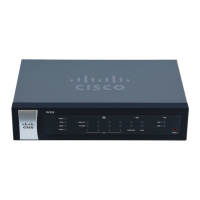VPN
Gateway to Gateway
86 Cisco RV320/RV325 Administration Guide
8
Remote Group Setup
Enter the settings for the Remote Group Setup for this router:
• Remote Security Gateway Type—Method for identifying the router to
establish the VPN tunnel. The Remote Security Gateway is the other router.
At least one of the routers must have either a static IP address or a dynamic
DNS hostname to make a connection.
- IP Only—Static WAN IP address. If you know the IP address of the
remote VPN router, choose IP Address, and enter the address. If you do
not know the IP address of the remote VPN router, select IP by DNS
Resolved, and enter the domain name of the router. A Cisco router can
get the IP address of a remote VPN device by DNS Resolved.
- IP + Domain Name (FQDN) Authentication—This router has a static IP
address and a registered domain name, such as
MyServer.MyDomain.com. If you know the IP address of the remote
VPN router, choose IP Address, and enter the address. If you do not
know the IP address of the remote VPN router, select IP by DNS
Resolved, and enter the domain name of the router. Cisco routers can
get the IP address of remote VPN device by DNS Resolved.
- IP + E-mail Address (USER FQDN) Authentication—This router has a
static IP address and you want to use an E-mail address for
authentication. If you know the IP address of the remote VPN router,
choose IP Address, and enter the IP address. If you do not know the IP
address of the remote VPN router, select IP by DNS Resolved, and enter
the real domain name of the router. Cisco routers can get the IP address
of remote VPN device by DNS Resolved.
- Dynamic IP + Domain Name (FQDN) Authentication—This router has a
dynamic IP address and a registered Dynamic DNS hostname (available
from providers such as DynDNS.com). Enter a Domain Name to use for
authentication. The domain name can be used only for one tunnel
connection.
- Dynamic IP + E-mail Address (USER FQDN) Authentication—This
router has a dynamic IP address and does not have a Dynamic DNS
hostname. Enter an Email Address to use for authentication.
If both routers have dynamic IP addresses (as with PPPoE connections),
do not choose Dynamic IP + Email Address for both gateways. For the
remote gateway, choose IP Address or IP Address by DNS Resolved.

